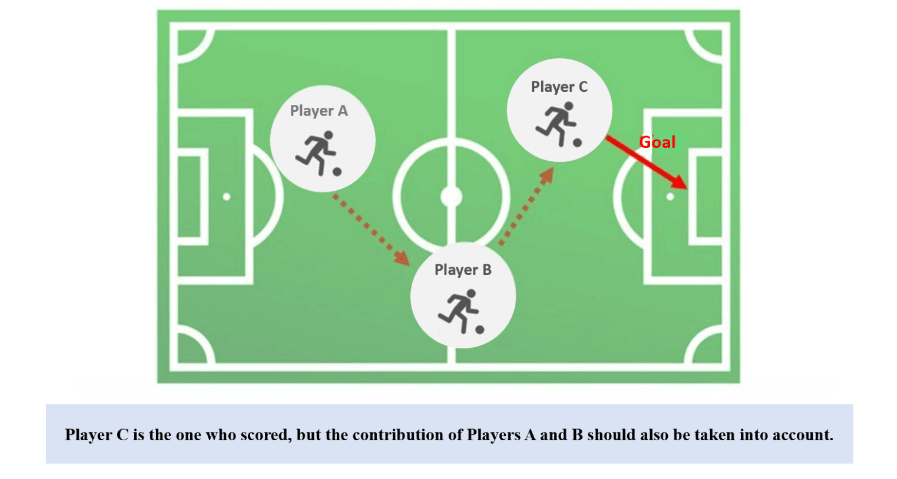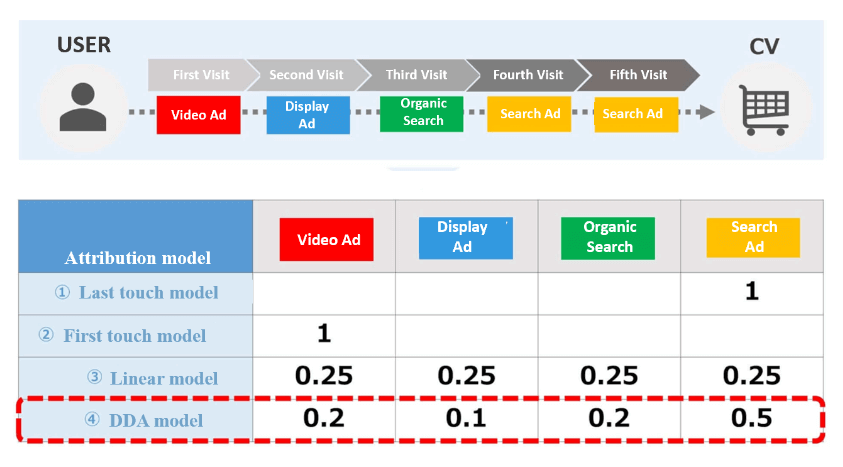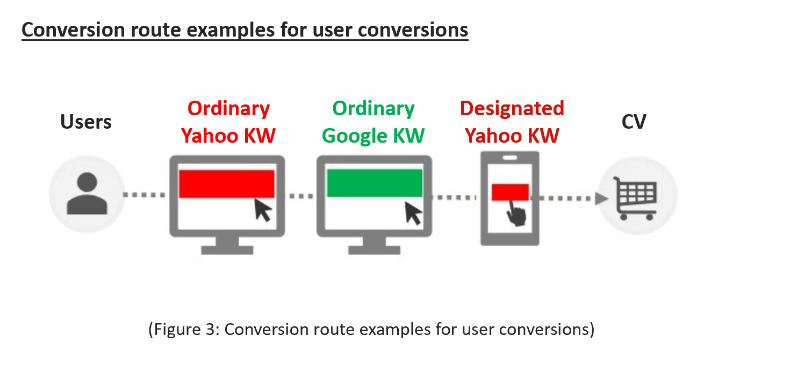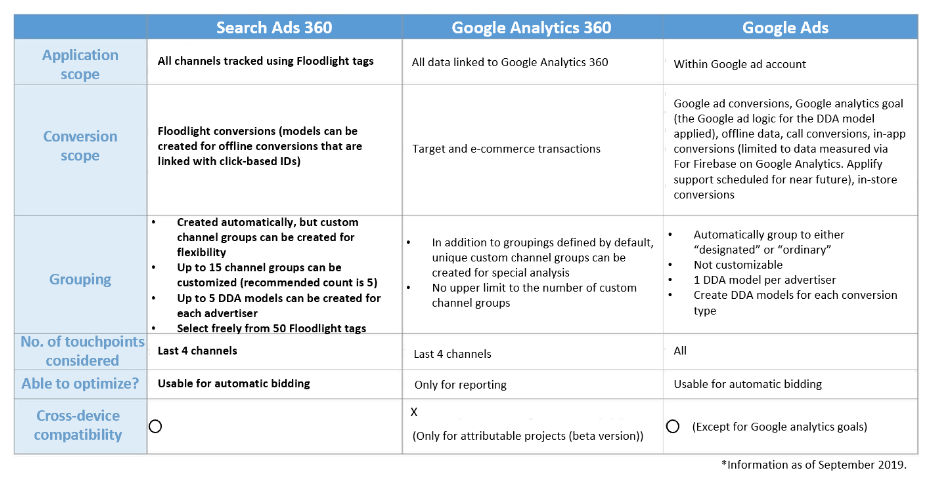The third chapter covered inventory-linked campaigns on Search Ads 360 geared towards the retail industry.
In this issue, we’ll introduce how to use the data-driven attribution (DDA) model of Search Ads 360. This enables appropriate evaluation and distribution of the contribution across media for search ads that have been reached prior to conversion, improving results through bid optimization.
An overview of attribution models
The number of digital ads delivered is increasing every year, and competition in the market is intensifying accordingly. In terms of user behavior, users often come into contact with multiple ads and channels before converting. In other words, the points of contact are becoming more diverse.
For example, even when a user purchases the same product, the process of conversion varies. The decision-making of users is greatly influenced by the ads and media information they come into contact with, so it’s important to understand which points of contact have a significant impact on user decision-making and conversion. In other words, by understanding and analyzing the results of each point, it’s possible to improve ad performance.
The concept of evaluating the contribution of each point of contact to the conversion is called attribution.
Let’s use a soccer analogy to illustrate attribution. Player A steals the ball from the opponent and passes it to Player B. If Player B passes to Player C who makes a shoot and scores, Player C usually gets the most credit for scoring the goal. But what would have happened had Player A not stolen the ball from the opponent? What would have happened had Player B’s pass failed? It’s true that Player C is the one who scored, but Players A and B both deserve recognition for their contribution in assisting Player C’s goal. That’s the idea behind attribution.
Similarly, when evaluating the results of an ad, it’s necessary to evaluate the “assist” of each ad not only immediately before the conversion, but along the entire path that led to the conversion.

Player C is the one who scored, but the contribution of Players A and B should also be taken into account.
The main evaluation models for attribution include first touch, last touch, and the DDA model introduced here. So, which touch points should be evaluated when evaluating advertising results?
The data-driven attribution (DDA) model
- Last Touch Model
The last touch model is an evaluation method that assigns contribution to the last clicked ad in the conversion path. Since this is the contact closest to the conversion, it’s an evaluation method that makes it easy to consider cost-effectiveness. - First Touch Model
The first touch model is an evaluation method that assigns contribution to the first ad clicked in the conversion path. This is a proactive evaluation method for evaluating contacts with big words and users with low awareness. - Linear model
The linear model is an evaluation method that assigns an equal contribution to each contact point clicked on in the conversion path. It’s possible to equally assign a contribution to each contact point. - Data Driven Attribution (DDA) Model
The DDA model is an evaluation method that automatically assigns a contribution to the advertisement that contributed most to conversions based on historical data. Unlike the linear model, the DDA model calculates and assigns the contribution of each ad strategy to the entire conversion path, making it possible to identify ads with high performance. Another advantage of this method is that even if multiple devices are crossed on the way to a conversion, the contribution can be assigned to the actions taken on each device.

Using the DDA model assigns evaluations to each action in the conversion path, even across devices. Understanding the contribution of each ad result calculated from past data allows users to discover potential measures that the Last Touch Model missed.
Taking into account the potential of new measures and assigning different contribution levels makes it possible to improve bidding accuracy, increasing the number of conversions and improving CPA.
Put simply, the DDA model is an effective model for acquiring conversions efficiently.
Benefits of using DDA in Search Ads 360
As a premise, the DDA model can be used for reporting in Google Analytics 360 and for ad delivery in Google Ads, even if users have yet to implement Search Ads 360. Now we’ll explain why the DDA model should be used in Search Ads 360 and how it compares to the DDA model in Google Analytics 360 and Google Ads.
One of the main features of the DDA model in Search Ads 360 is that users can use the results of the DDA model across media for monitoring and bidding sources for channels that are tracked with Floodlight tags. This enables centralized management of channels that have been fragmented and optimization of automatic bidding strategies across media, which can be expected to increase conversions and improve CPA.
As introduced in previous articles, Search Ads 360 enables automatic bidding across each engine for listing ads allowing for optimization. With Search Ads 360, even the DDA model can achieve optimization beyond the engine.

For example, assume that the three patterns shown above exist: Ordinary Yahoo keywords, ordinary Google keywords, and designated Yahoo keywords. With media measurements, the Yahoo! ad and Google ad are measured with separate media tags, so the conversion counts will overlap, causing bidding optimization to take place for each media.
Let’s look at how using Search Ads 360 will change the contribution ratings.
Google ads enable optimization via the DDA model, but Yahoo! ads don’t support DDA models. However, by using Search Ads 360, DDA models can be applied to Yahoo! ads as well.
By using common tags on the DDA model for the Yahoo! and Google ads, overlaps are eliminated for ads that come into contact on the path to conversions, allowing bid optimizations to take place by appropriately rating the contributions across media.

That’s not all DDA models have to offer on Search Ads 360. If the same Floodlight tag is shared beyond listing ads (including Display & Video 360), contributions are assigned for display ad clicks as well, enabling DDA models to be created beyond listing ads.
Furthermore, Search Ads 360 enables users to customize groupings that assign contributions based on the type of interaction when creating DDA models. These groupings can be assigned automatically. When generated automatically, they are grouped as either “ordinary” or “designated.” If users would like to model interaction types that don’t fall under either of the basic ones, they can create custom channel groups (i.e. brand keywords, generic keywords, focused keywords, etc.)
Using this feature allows users to visualize how custom channel groups interact to drive conversions. Five DDA models can be created per advertiser, allowing differences between models to be compared. This uniqueness allows the best model to be selected for bid optimization.

Furthermore, the Search Ads 360 DDA model is relatively easy to implement, which is another reason we recommend it. Functions introduced in the second and third article in this series require special tag setting configurations and feed preparations, but the DDA model is easy to implement because it only requires tag and setting configurations on the Search Ads 360 administration screen. We will explain the detailed instructions for configuration in the next article. Be sure to check it out, especially if you’re already using Search Ads 360 but haven’t been able to use DDA models, as well as if you’re beginning to consider using Search Ads 360.
Summary
This article introduced the concept of DDA models and the advantages of using it in Search Ads 360. If you’re interested in using Search Ads 360, please feel free to contact us. The next article in the series will introduce specific ways to configure Search Ads 360, as well as case studies of improved results.
Want to know more about Search Ads 360?
Contact us to discuss how we can work together.

Irep Inc. is an award-winning global digital marketing agency based in the San Francisco Bay Area. Our headquarters are in Tokyo and our network spans more than 20 countries. In Japan, we are ranked No. 1 for performance-based marketing. We also offer highly specialized market entry, as well as integrated marketing and localization services. Since 1997, our data-driven solutions have effectively led our diverse international clientele to continuous success in Japan, Asia, and beyond.
Irep Inc.
LinkedIn: https://www.linkedin.com/company/irepinc
Email: info@irep.inc
Address: 900 Concar Dr. Suite 400, San Mateo, California 9440



